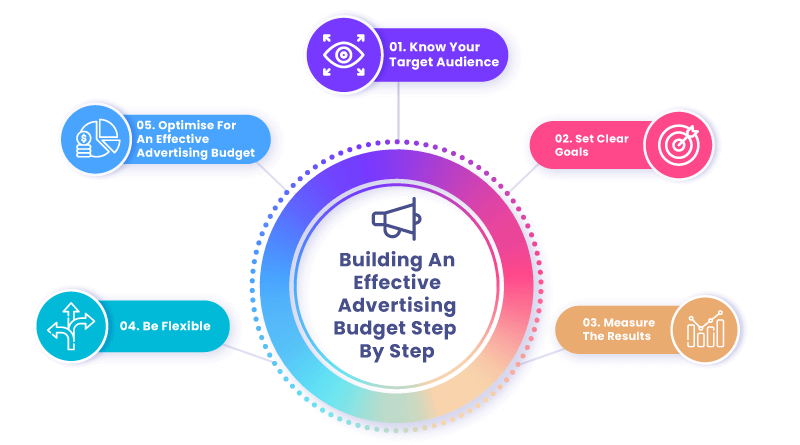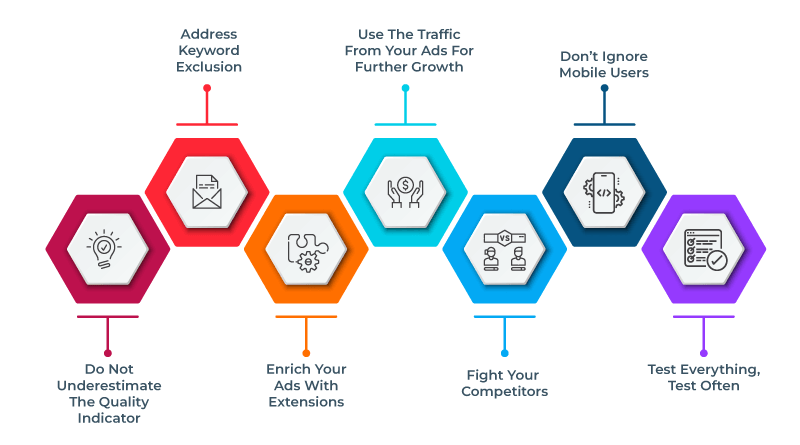I don’t suppose you need any introduction to Google’s advertising system, formerly known as Google AdWord, now known as Google Ads. If you use it, you know it can bring in a lot of conversions (purchases, room bookings, etc.), but I’m sure you also know that if it’s set up right, it does it all much more cheaply.
Talking about conversions, website speed, it UI/UX and other factors like website hosting services also play a crucial role in it. Google serves nearly 4 billion queries a day, which essentially gives you 4 billion opportunities to reach your audience with your marketing messages. Of course, if you want to get the most out of Google’s advertising system (whether it’s Search or Display), you need a solid Google Ads strategy to do so, because you’re up against some stiff competition.
Of course, every company, target, and audience to target is unique, but we have a few tips that every advertiser is guaranteed to benefit from in their own Google Ads strategy – let’s get started!
5 Essential Steps To Developing An Effective Advertising Budget
In business, developing an effective advertising budget is key to success. A well-constructed budget can help you ensure that all financial resources are used efficiently – increasing your company’s revenue. The following are some of the essential steps that will help you make the most of your advertising budget.
Building an effective advertising budget is a complex task.
Why Is It Worth The Energy Invested?
- It will help you to define your company’s goals and strategy, which advertising activities you need to achieve your goals, and which activities are not worth doing.
- It allows you to take market trends, customer needs, and competitors’ activities into account and then develop your company’s advertising strategy accordingly.
- You can consciously plan the distribution of advertising costs over time and the amount to spend on advertising.
- Use your resources effectively and in a targeted way to increase revenue and brand awareness, helping your company to grow.
Building An Effective Advertising Budget Step By Step

Step 1 – Know Your Target Audience
A thorough understanding of your target audience is crucial to developing an effective advertising budget. By knowing your target audience, you can create advertising campaigns that appeal to them and reach them where they are most active.
Knowing them will also help ensure that your advertising efforts reach the right people and that you don’t waste them on an irrelevant audience. And understanding them allows you to tailor your messaging and branding to successfully connect with them.
If your target audience is primarily:
- Active on social media, it may be more beneficial to spend a larger portion of your budget on social media advertising.
- Is made up of older adults, then a traditional and formal tone may be more appropriate for your ads.
- Is made up of young adults, then you’ll likely be a winner with direct and casual communication.
All in all, you need to know the audience you want to sell to. This is the first step in developing an effective advertising budget. This step allows you to create campaigns that resonate with your audience.
Analyze demographic and psychographic data and behavioral patterns! Demographic data refers to the characteristics of a population, such as age, gender, income, education, and occupation. This information can be useful in understanding the basic characteristics of your target audience and can help you create advertising campaigns that attract your specific target group.
Psychographic data refer to the attitudes, interests, and values of the population. You can use this information to understand the lifestyle and personality of your target audience. It can help you create advertising campaigns tailored to their interests and values.
Behavioral patterns refer to the actions and habits of the population. Knowing them will help you understand the habits and routines of your target audience so that you can reach them with your advertising campaigns at the right place and time. You can gather this information in several ways, including:
- Market Research
- Surveys
- Analyses
You can use this data to build a detailed profile of your target audience. Then use the information to create a successful advertising campaign.
Related: How to Boost Sales with Facebook Catalog Ads?
Step 2 – Set Clear Goals!
SMART
SMART is an acronym that stands for Specific, Measurable, Achievable, Relevant, and Time-bound is made up of words. By setting them, you can ensure that you are working towards clear and defined goals and that the success of your campaign can be measured.
Specific
Your goals should be clear and specific. For example, “increasing brand awareness” is not a specific goal. But “increase brand awareness by reaching 100,000 people in the next 6 months” is a specific objective.
Measurable
Objectives must be measurable. This means that you need to track your progress and be able to determine whether you have achieved your goal. For example, “Increase brand awareness by reaching 100,000 people in the next 6 months” will be measurable because you can track how many people you reach.
Achievable
Your goals must be achievable. This means they must be realistic, taking into account your resources and constraints. For example, “increase brand awareness by reaching 1 billion people in the next 6 months” is not achievable for most SMEs.
Relevant
Your goals should be relevant to your business and its objectives. For example, “Increase brand awareness by reaching 100,000 people in the next 6 months” is relevant to your business if you want to increase your brand awareness and customer base.
Time-bound
Your objectives should have a specific deadline. You need to set a specific date by which you want to achieve your goal. For example, “Increase brand awareness by reaching 100,000 people in the next 6 months” is time-bound because it has a specific deadline of 6 months.
Step 3 – Measure The Results!
This means tracking metrics such as:
- Achievement
- Engagement
- Conversion rate
Reach
The number of people who have seen your ad. This metric allows you to determine the effectiveness of your advertising efforts in terms of audience size. It can be an excellent indicator of the effectiveness of your advertising channels and can help you determine which channels are effective in reaching your target audience.
Engagement
Refers to the level of interaction achieved by your ad.
It is a measure of how effective your ad is at capturing the attention of your audience and encouraging them to take action. Engagement metrics can include clicks, likes, shares, and comments.
Conversion rates
They refer to the percentage of people who took action as a result of your ad. They are particularly important for measuring the success of campaigns that aim to generate leads or sales. By tracking conversion rates, you can determine the effectiveness of your advertising in driving conversions and identify areas for improvement.
ROI
Return on Investment is a measure of the profitability of an advertising campaign. You can measure the success of your campaigns in terms of return on investment. By tracking ROI, you can make data-driven decisions about your advertising budget and adjust your strategies as needed to improve ROI. These metrics provide valuable insights into campaign performance and help you identify areas for improvement.
Step 4 – Be Flexible!
Strive to stay at the forefront of an ever-changing advertising environment! The advertising industry is constantly evolving, with new technologies, platforms, and trends emerging. If you want to maximize the return on your advertising budget, it’s essential to stay informed. One way to stay ahead of the curve is to stay informed about new technologies and platforms.
For example, in recent years, new social media platforms such as TikTok and Clubhouse have emerged as popular advertising channels for many brands. By learning about new platforms, you can identify opportunities to expand your reach and connect with new audiences.
The use of interactive, shoppable advertising, for example, has become increasingly popular in recent years and can again improve the effectiveness of your advertising campaigns.
- Be open to the possibilities!
- Experiment with new types of ads!
- Test new platforms and channels.
- Try new strategies!
By being open to new possibilities, you can identify ways to improve ROI – so you can stay ahead of the trends.
Step 5 – Optimise For An Effective Advertising Budget!
Regularly analyzing and adjusting your advertising budget is an essential part of managing an effective advertising strategy. By analyzing and adjusting your budget regularly, you can ensure that your advertising activities are delivering the ideal return on investment and that you are allocating your resources efficiently.
Track and regularly analyze the key metrics mentioned above, such as reach, engagement, conversion rates, and ROI. This data can provide valuable insights into the performance of your campaigns and identify areas for improvement. Once you’ve identified areas for improvement, you can use optimization techniques to improve the ROI of your ad campaigns.
You can adjust the budget as necessary. If, for example, you find that a particular advertising channel is generating high ROI and conversions, you may want to allocate more of your budget to that channel. Constantly test and experiment with new strategies, platforms, and ad types – as mentioned earlier.
These 5 steps above are the foundation for successfully building your advertising campaigns within Google Ads. However, other factors can also influence the success of a campaign in the online world.

Now let’s look at some of them.
1. Do Not Underestimate The Quality Indicator
I’m always shocked when a company’s online marketing audit doesn’t even look at these metrics at all for a high-spending Google Ads account. Google uses a score called the “quality metric” to determine the quality of your ads. To calculate the quality score, the system looks not only at the ad (more specifically, its click-through rate) but also at the landing page associated with it and the relevance of the keywords you bid on. The quality metric determines how much your ad will “cost” and also affects its display rate.
This shouldn’t come as a surprise, as it is in Google’s interest to display the best quality, most relevant ads to its users – the lower price option is certainly an incentive to do so, and it also means that you will rank better for less if you have good quality metrics.
So make sure the ad is relevant to the keywords you are bidding on and that the landing page offers what the ad promises. Another critical aspect of the landing page is the mobile-first design for an excellent user experience.
Related: 5 Quick Ways to Generate Leads
2. Address Keyword Exclusion
Keywords are used first and foremost to specify the searches you want your ads to appear for. However, Google Ads also allows you to use so-called “exclusion” keywords, which allow you to specify the keywords for which you don’t want your ads to appear.
Exclusion keywords help you avoid showing your ads to users who would certainly not be interested in what you have to offer. The keywords that users type in can tell you a lot about the intent behind the search: for example, if someone uses the word “free” in their search, they are probably not interested in the paid service or product you are advertising. It is therefore likely that they will not click on it, thus reducing the click-through rate and quality of your ad.
If the user does click on the ad (and they certainly don’t want to spend money, they are looking for “free” stuff), you will have to pay for that click, whether or not there is a conversion. You can mark the excluded keywords in your keyword list by putting a minus sign in front of them. Depending on the purpose of your ad, you may also want to exclude “images” and other terms that do not indicate a buying intent.
3. Enrich Your Ads With Extensions
You can add more information to your ads with the help of ad extensions with a catchy names. Well-chosen and used, these can increase the click-through rate of an ad many times over. They also ensure that users learn more about your ad before they click on it – if they decide that your offer isn’t for them, at least they won’t click unnecessarily and will use up your ad budget.
You can choose from a variety of ad extensions: some that display additional links below the primary link (this also helps you rank your ad higher in the results), or you can provide a phone number that mobile users can call instantly and conveniently. People prefer to engage with an ad that makes it easy for them with such convenient features. Fortunately, using extensions (even if you use more than one at a time) is completely free, so it doesn’t change the cost of the ad.
4. Use The Traffic From Your Ads For Further Growth
Paid ads can help you attract large amounts of traffic quickly, but of course, they’re not free. So it’s worth thinking about how you can use this traffic to reach an interested audience more cost-effectively in the future.
Use your advertising to build a community around your brand. Try to get the email addresses of as many users as possible on landing pages so that you can retarget them with your emails or remarketing ads. You can also use these email addresses to target your Facebook Ads. Position your Facebook and Instagram page icons so that all visitors can find them, so you can turn visitors attracted from Google Ads into followers.
5. Fight Your Competitors
In the cut-throat world of online advertising, it’s common practice for competitors to bid on each other’s brand names when targeting ads so that they’ll show up when a user searches for a competing brand name.
Although this may not be the most ethical method, “business is business” – everyone does it, and one or two of your competitors may bid on your brand name. You have no choice but to fight back in the same way!
6. Don’t Ignore Mobile Users
There are still advertisers who are not aware of the role of a mobile-first approach in online marketing. Advertisers who aren’t prepared for this traffic will certainly fall behind quickly. People search differently on their mobile devices than on a computer – because they are mostly not used at home, they often search for things using shortcuts and voice recognition.
Advertisers need to adapt to these trends in both their advertising (keywords) and landing pages (design), taking into account that smartphone users are generally more impatient, as they usually only need a quick search.
7. Test Everything, Test Often
As much as you may have understood things yesterday, they may work very differently today. Internet marketing is constantly changing and the only way to know for sure if something works is to test it. Veteran marketers A/B test almost every possible element to improve their ads, landing pages, and even their targeting. Try different keywords, target groups, and areas, and even reword the text of your ads/landing pages if you need to.
The above tips cover only the tiny tip of a huge iceberg. Google Ads is a much deeper, more complex system, which is constantly being updated and new features added. Keeping up with this requires a special kind of work, and of course, years of experience are not the least of your concerns.
If you don’t want your ads to just take your money because of mis-targeting or poor design, then leave them to a professional online marketing team! I hope I’ve been able to help you within the framework of this article, and that you’ve gained some knowledge in the ever-changing world of Google Ads. We want to know what you think, so please add 1 comment to the article so that we can improve. Thank you.















